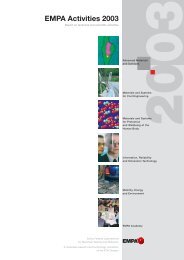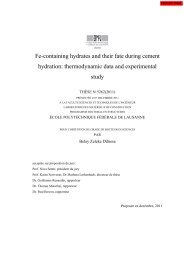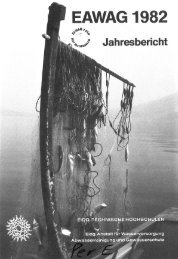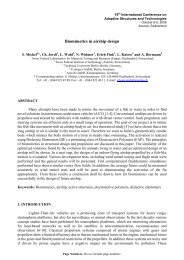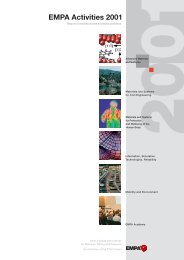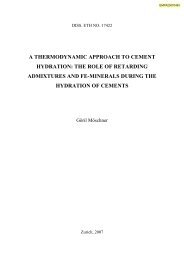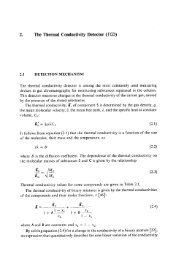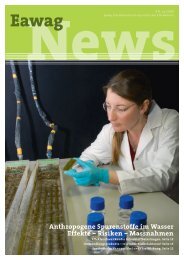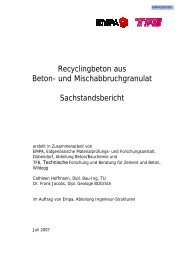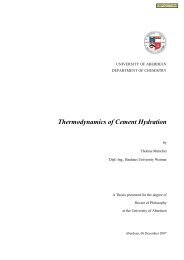Entire volume - Eawag
Entire volume - Eawag
Entire volume - Eawag
You also want an ePaper? Increase the reach of your titles
YUMPU automatically turns print PDFs into web optimized ePapers that Google loves.
Ice Cover on Lakes and Rivers<br />
Climate Trends Inferred from Historical Records<br />
The longer and colder a winter is, the earlier lakes freeze and the<br />
later they thaw. This is obvious intuitively even if we ignore the<br />
underlying meteorological complexities. EAWAG decided to take a<br />
closer look at this phenomenon by analyzing long series of historical<br />
observations of the timing of freeze-up and break-up of<br />
lakes such as the Lej da San Murezzan in Switzerland and Lake<br />
Baikal in Siberia. From these data, conclusions can be drawn<br />
about past and future climate forcing.<br />
Causally, the formation of an ice cover on<br />
lakes and rivers in winter and its disappearance<br />
in the following spring are the end<br />
results of complex series of mixing, freezing<br />
and thawing processes driven ultimately by<br />
many meteorological forcing factors. By far<br />
the most important of these factors is air<br />
temperature, so that the formation or disappearance<br />
of ice on a lake or river can often<br />
be viewed in an empirical sense simply as<br />
a temporally integrated response to the<br />
seasonal variability in air temperature. The<br />
reverse is also true, allowing conclusions<br />
about the air temperatures that prevailed<br />
in the vicinity of a water body at some time<br />
in the past to be drawn from historical observations<br />
of the timing of freeze-up and<br />
break-up. Since air temperature is a very<br />
spatially coherent meteorological variable –<br />
Freeze-up date<br />
January<br />
December<br />
November<br />
19 EAWAG news 58<br />
Lake Baikal<br />
Mendota<br />
Kallavesi<br />
Red River<br />
air temperatures are usually well correlated<br />
over several hundred kilometers – historical<br />
variations in the timing of break-up do not<br />
merely reflect variations in local weather, but<br />
– much more usefully – variations in regional<br />
or even supraregional climate.<br />
Shorter and Thinner Ice Cover –<br />
A Response to Climate Change?<br />
Historical observations of the calendar<br />
dates of freeze-up (defined as the first day<br />
of total ice cover) and break-up (defined as<br />
the first completely ice-free day) of lakes<br />
and rivers in Canada, the USA, Finland,<br />
Switzerland, Russia and Japan provide<br />
consistent evidence that lakes and rivers<br />
around the Northern Hemisphere have been<br />
freezing later and thawing earlier since at<br />
least the middle of the 19th century (Fig. 1)<br />
Fig. 1: Time-series of the calendar dates of freeze-up (left) and break-up (right) for a small but representative selection of lakes and rivers distributed around the northern hemisphere.<br />
Data presented as a 10-year running mean, from [1].<br />
Break-up date<br />
May<br />
Kallavesi<br />
Lej da<br />
S. Murezzan<br />
Tornionjoki<br />
Lake Baikal<br />
Red River<br />
Mendota<br />
1800 1820 1840 1860 1880 1900 1920 1940 1960 1980 2000 1800 1820 1840 1860 1880 1900 1920 1940 1960 1980 2000<br />
Year<br />
Year<br />
June<br />
April<br />
March<br />
[1]. These long-term historical freezing and<br />
thawing trends average around 6 days per<br />
100 years, which corresponds to an air temperature<br />
increase of 1.2 °C per 100 years.<br />
Thus historical cryophenological data from<br />
lakes and rivers lend support to the hypothesis<br />
of past and current global warming, but<br />
2<br />
1 Mendota<br />
2 Red River<br />
1<br />
6<br />
3 Tornionjoki<br />
4 Kallavesi<br />
3 4 5<br />
5 Lake Baikal<br />
6 Lej da<br />
S. Murezzan




